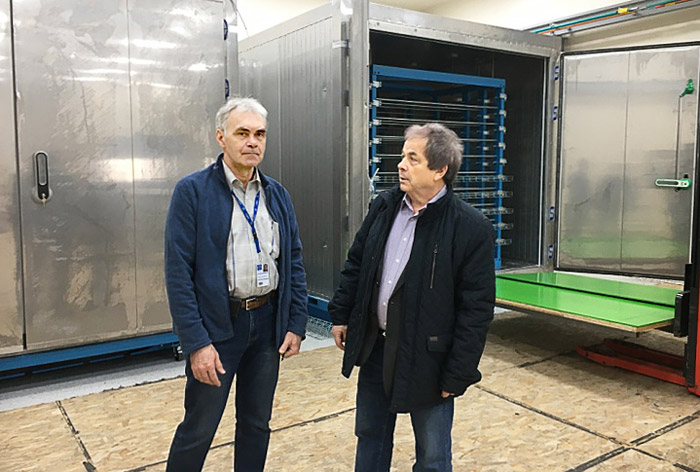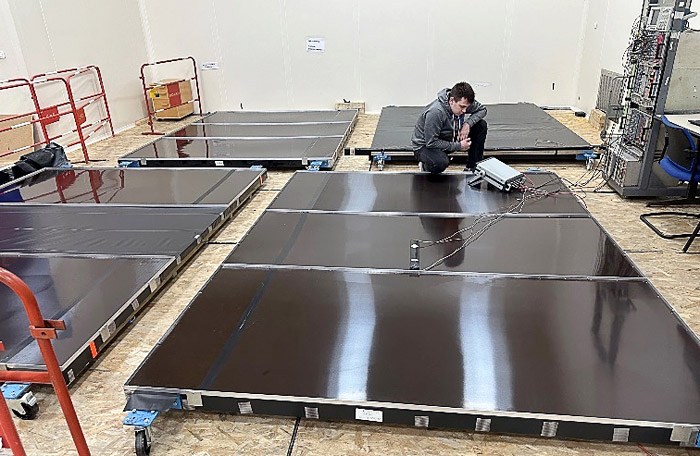
Electronic english version since 2022 |
The newspaper was founded in November 1957
| |
Meridians of cooperation
Modernization of the CMS facility at CERN:
a significant stage of JINR's commitments has been completed
The staff of VBLHEP JINR, within the framework of the second phase of modernization of the CMS facility, currently participate in the project to develop a calorimeter with high granularity HGCaL that will significantly increase spatial and temporal resolution and will be able to operate efficiently in the high luminosity conditions of the Large Hadron Collider at CERN.
The HGCaL calorimeter consists of 47 sequentially arranged absorber layers (along the beam), with cassettes positioned in the gaps between them. Geometrically, they are 30- or 60-degree segments with active devices of the detector mounted on copper cooling panels. Scintillation cells with light registration using SiPM and silicon sensor units positioned in the area of strong radiation load are used as detecting components. In total, the calorimeter uses 660 cassettes of various configurations (with a total weight of more than 215 tons for one end part). The calorimeter operates in a thermally insulated volume at a temperature of -30°C.
To test calorimeter units at VBLHEP JINR, a facility for testing HGCaL has been designed, developed and put into operation at CERN.
Specialists from JINR and BSU (Minsk) have developed a technology for manufacturing cooling plates for HGCaL calorimeter cassettes. Physicists and engineers of VBLHEP JINR are extensively involved in the development of a stand to test the operability and properties of the cassettes after assembly. For possessing such a stand in Russia, two thermally insulated chambers were manufactured and delivered to CERN. The design of these cameras mounted in a room for assembling cassettes with touch-sensitive devices is shown in the top photo. After assembly, the cassettes are tested under conditions close to real ones, at a temperature of -30°C. Cassettes in the amount of 10 pieces are installed in a rack positioned inside a thermally insulated chamber measuring 3.0 x 3.0 x 2.5 m.

S.V.Afanasiev and A.I.Malakhov are discussing the results of testing thermally insulated chambers
Two 2.4 x 3.0 m scintillation trigger planes are positioned at the top and bottom of the thermally insulated chamber to test the operability and to measure the properties of the detecting components and electronics positioned on the HGCaL cassettes using cosmic rays. The facility process and calibration of the trigger planes are shown in the bottom photo.

V.V.Ustinov is adjusting the trigger planes of the stand for measuring the properties of the hadronic calorimeter cassettes
When cosmic particles pass through a complex of tested cassettes, the activation of the corresponding sensors is registered using the readout electronics and if they coincide with the trigger signal, confirms the functionality of the sensor. A Monte Carlo model of a test stand in cosmic rays has been developed, with the help of which the dimensions of the trigger planes and the configuration of the scintillator plates are optimized.
Developing a stand for testing cassettes was carried out under the supervision of S.V.Afanasiev and A.I.Malakhov. VBLHEP physicists and engineers V.V.Ustinov, E.V.Sukhov, N.V.Gorbunov, A.M.Kurenkov, Yu.Vershov, P.D.Bunin and B.V.Dubinchik took an active part in this work.
Great assistance in the implementation of this stage of the CMS modernization project was provided by JINR Scientific Leader, Academician of the Russian Academy of Sciences Victor Matveev.
Vladimir KARZHAVIN,
Leader of the CMS project at JINR